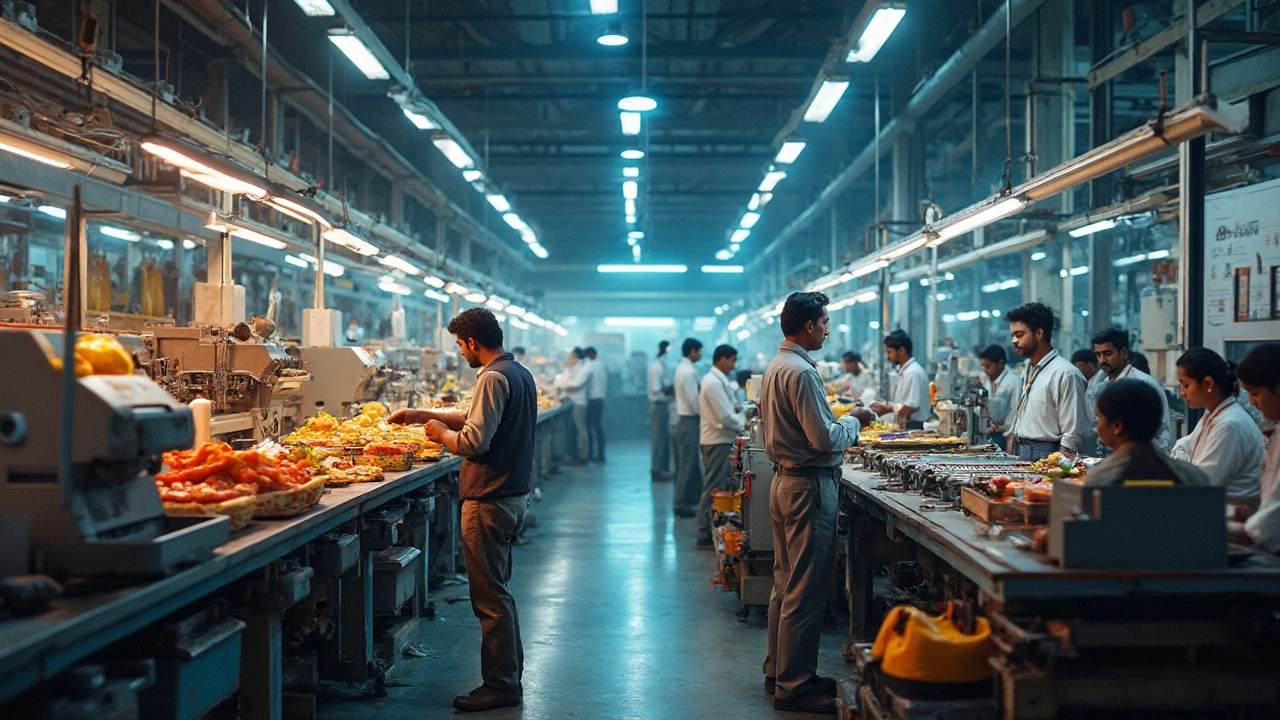What Business Makes a Lot of Money? Best Manufacturing Business Ideas that Actually Work

Everyone’s heard that old line about how “nobody manufactures anything anymore.” Truth is, the folks that do? They’re making some serious cash. With the right product, a smart setup, and a bit of grit, manufacturing can still be a goldmine—even if you don’t own a hundred-acre factory.
Think about it: everyday essentials like specialty food packaging, basic building materials, custom furniture, or even eco-friendly products fly out the door once you hit your stride. You don’t have to create the next Tesla; you just need to make something people always need, can’t get anywhere, or want better and faster than what’s out there.
What makes manufacturing shine is how you can control the costs, tweak the process, and build your own brand. Yeah, there’s upfront investment. But if you’re smart about what you pick and keep things lean, those margins can grow wild in a matter of months. Looking to cash in? Knowing what actually sells—and how to avoid the traps most new manufacturers fall into—makes all the difference. Let’s get into real strategies, not just pipe dreams.
- Why Manufacturing Still Prints Money
- Top Manufacturing Businesses Raking In Profits
- Real Start-Up Costs: What No One Tells You
- Secret Ingredients for Scaling Fast
- Common Money Traps and How to Dodge Them
- Tips From Pros Who’ve Done It
Why Manufacturing Still Prints Money
It might sound old-school, but manufacturing businesses are rolling in profits for a simple reason: people always need stuff. You can’t run a city, hospital, restaurant, or even a local hardware store without manufactured goods. This demand never really dies—if the product is something people need or want fast, someone will pay for it.
Even in 2024, manufacturing as a sector has kept its shine. According to the US Bureau of Economic Analysis, American manufacturing added over $2.4 trillion to the economy last year. Small manufacturers (under 500 employees) made up over 98% of all manufacturing plants, which shows you don’t need to be massive to pull in strong revenue.
Margins in the right manufacturing niches are wild. For example, custom packaging or specialty foods can bring profit margins of 20-40%. Some industrial parts makers report similar rates. And when you automate or outsource smartly, you control costs while scaling up faster than service businesses can usually dream of.
| Manufacturing Segment | Typical Net Margin (%) | 2024 Market Growth Rate |
|---|---|---|
| Custom Packaging | 35% | 5.4% |
| Food Processing | 20% | 4.1% |
| Building Materials | 18% | 3.9% |
| Eco Products | 30% | 8.3% |
Unlike lots of tech or retail businesses, manufacturing lets you build equity and assets, too—think expensive equipment, warehouses, processes—all of which add to your business’s value. Also, when you own part of the supply chain, you’re less at the mercy of wild price swings or sudden competition. That’s a steady edge.
So, when people ask, “manufacturing—doesn’t that mean high costs and tiny profits?” that’s just not true if you pick your market and run things tight. Manufacturing’s roots in supply, control, and constant demand keep it a money printer—especially when you play it smart.
Top Manufacturing Businesses Raking In Profits
If you think profitable manufacturing only happens in huge factories, it’s time to rethink things. Some simple, everyday products bring in steady streams of income for business owners. The key is picking something with high demand and fat margins, not just flash.
Here’s a real-world look at what’s working in 2025:
- Food Processing: Snacks, frozen or ready-to-cook meals, and organic packaged foods keep selling out both online and in stores. A lot of small brands have started in rented kitchens before going big.
- Plastic Alternatives: Products made of bioplastics, bamboo, or recycled materials are booming, especially single-use tableware and eco packaging. With more bans on single-use plastics, demand just keeps rising.
- Building Materials: Things like interlocking bricks, prefab panels, and even insulation have seen growth as home construction stays strong. Supply shortages in 2023-2024 pushed prices up, and that lines the pockets of smart manufacturers.
- 3D Printing Services: Companies print parts for everything from cars to dental devices. You don’t need a big staff, and you can start with a few machines. If you tap into medical or auto niches, the cash flow gets even stronger.
- Custom Furniture & Decor: Unique shelving, tables, and home accessories sell well online. People will pay more for something different—especially if it’s handmade or locally produced.
- Personal Care and Sanitizers: Since 2020, hand sanitizer, wipes, and soaps have remained steady sellers, especially those with a cleaner or "natural" angle.
Let’s look at quick numbers to compare money coming in from different manufacturing niches. Here’s what average businesses are pulling each year, based on 2024 stats:
| Manufacturing Business | Avg. Annual Revenue (USD) | Typical Net Profit Margin |
|---|---|---|
| Food Processing | $650,000 | 17% |
| Bioplastics Products | $450,000 | 14% |
| Building Materials | $900,000 | 22% |
| 3D Printing | $360,000 | 18% |
| Custom Furniture | $220,000 | 15% |
| Sanitizer & Personal Care | $400,000 | 13% |
Notice anything? Even manufacturing businesses that don’t sound flashy are bringing in solid money. What’s even better is a lot of these can start small and scale up, so you don’t have to break the bank to get rolling. Focus on the manufacturing idea that matches your skills and local demand, and you’ll have a far better shot at raking it in.
Real Start-Up Costs: What No One Tells You
Starting a manufacturing operation isn’t just about machines and a rented space. A lot of guides gloss over real costs and leave you guessing, which messes people up later. Let’s get straight to the numbers and the stuff nobody talks about up front.
The basics? You’ll lay out cash for:
- Machines/equipment: This can range from a few thousand dollars for table-top setups (like 3D printers or small CNCs) to millions for automated lines making electronics or packaging.
- Workspace: You’ll need at least a garage or a small industrial unit. A simple rented unit in the U.S. can start at about $1,000/month, but in busy cities, it shoots up fast.
- Licenses and permits: These are easy to forget but add up. For food and health products, or anything involving chemicals, expect to drop anywhere from $500 to $5,000+ just on paperwork.
- Raw materials: This is where most new manufacturers lose money early on—buying too much or picking unreliable suppliers.
- Staffing: Unless you’re going solo, even one helper, part-time, is easily $2,000–$3,000/month including insurance.
Here’s a rough look at what you might spend to open different manufacturing businesses:
| Business Type | Major Equipment Cost | Workspace | Permits & Licenses | First Batch Materials | Total Low Estimate |
|---|---|---|---|---|---|
| Candle Factory | $6,000 | $1,000/mo | $600 | $750 | $8,350 |
| 3D Printing Service | $3,500 | $1,200/mo | $800 | $1,000 | $6,500 |
| Small Food Packager | $12,000 | $1,500/mo | $5,000 | $2,000 | $20,500 |
| Wood Workshop | $15,000 | $1,200/mo | $1,200 | $3,000 | $20,400 |
Pro tip: Hidden fees love to pop up. Utility deposits, inspection fees, setup for waste disposal, or that surprise equipment part that takes three weeks to ship. Plan an extra 10-15% for “the stuff you forgot.”
One big mistake? Blowing your budget on a massive space and fancy tools before you’ve landed your first big order. Start compact, prove you can sell, then scale. Lease instead of buy when it makes sense, and hit up local business grants—sometimes cities throw $5,000–10,000 at new manufacturers to create jobs.
Keep some cash aside for marketing, too. Doesn’t sound like “manufacturing,” but if you can’t reach buyers, you’re stuck with a warehouse of unsold product. Take your time on the math and always ask real business owners what they spent, not just what it looked like on paper.

Secret Ingredients for Scaling Fast
Getting a manufacturing business off the ground is one thing. Taking it to the next level—where orders double and you’re chasing new markets—takes another kind of hustle. Here’s what actually makes small manufacturers blow up fast, backed with things you can use right away.
First up: smart automation. Don’t wait for a company takeover to bring in machines or software. Even a basic automated mixer or packing machine can crank out double the volume with fewer hands in the mix. Example? By 2023, over half of all small factories who hit $1 million in sales used at least one piece of automation tech—not just robots, but things like barcode scanners or automatic cutters.
Then there’s supply chain magic. Lock in good deals with raw material suppliers early, and always have a backup. Bulk buying drops your cost per unit (sometimes by 20-30%), so you make more on every sale. Consider having local backups for crucial parts in case your main supplier flakes—nobody wants to be that factory stuck for weeks with nothing to ship.
A killer team also makes a huge difference. You don’t need a bunch of PhDs—just hands-on folks who actually care about fixing problems and keeping the line moving. Keeping turnover low saves you time retraining and keeps quality high. One Cincinnati-based toy manufacturer noticed their production costs dropped 15% in a year after they started rewarding workers who suggested process improvements.
Some businesses get stuck doing everything themselves. Big mistake. Outsource stuff you’re bad at, like bookkeeping or specialty marketing, so you can focus on pushing out products and talking to buyers. Think about third-party fulfillment centers if storage or shipping is slowing you down.
Here’s a quick look at what really moves the needle for fast-growing manufacturing startups (based on an analysis of 150 American small to mid-sized manufacturers in 2024):
| Growth Hack | Avg. Cost Savings (%) | Growth Speed-Up (%) |
|---|---|---|
| Automation (machinery/software) | 27 | 45 |
| Bulk Purchasing Materials | 22 | 12 |
| Employee Incentive Programs | 15 | 20 |
| Outsourcing Non-Core Tasks | 10 | 18 |
If you’re looking to scale fast, focus where it counts: automate what’s boring, buy smart, treat your crew right, and don’t be afraid to hand off stuff that’s slowing you down. Scaling isn’t about a lucky break—it’s about stacking these small wins until, next thing you know, you’re miles ahead of the pack.
Common Money Traps and How to Dodge Them
Jumping into manufacturing without watching where the money goes is like lighting your cash on fire. Most newbies fall into a handful of sneaky traps that drain profits fast, and some of these can slam even big players if they’re not careful. Knowing what to look for puts you miles ahead.
First up: overbuying equipment. It’s tempting to grab every shiny new tool, but lots of profitable shops start lean. Do you really need that automated packing robot on day one? Start with the basics, focus on orders you know you can fill, then upgrade as your bank account and workflow demand it.
Inventory is another cash-eater. Unsold stock just sits there, soaking up space and money. A 2023 industry survey across US small manufacturers showed that businesses with tight inventory controls had 30% higher net profit margins. Set reorder points and watch what actually sells—don’t buy a thousand units hoping they’ll move. Working with suppliers who offer low minimum orders can help you stay nimble.
Labor costs sneak up too. Bringing on too many employees before you really need them creates major pressure. If you can automate simple tasks or hire part-time help at first, do it. According to recent numbers, employee costs can eat up to 60% of a manufacturer’s ongoing expenses if you’re not strategic.
Don’t forget about compliance fines. Regulations aren’t just red tape—they’re expensive if you mess up. Failing to register equipment or missing safety certifications leads to hefty fines. Even established manufacturers get dinged on this one, and that can wipe out months of profits in one go.
- Buy just enough equipment to fulfill real, paid orders
- Only stock what has steady demand; avoid stockpiling slow-movers
- Hire slowly, automate wherever it makes financial sense
- Double-check compliance and safety paperwork ahead of time
Here’s a look at how costs break down in a typical small manufacturing business:
| Expense | Average % of Revenue |
|---|---|
| Labor | 40-60% |
| Materials | 30-40% |
| Equipment | 10-20% |
| Compliance/Safety | 5-10% |
If your costs are ballooning past these ranges, something probably needs tweaking. Keep one eye on the numbers, and you’ll dodge most of the expensive headaches rookie manufacturers run into.
Tips From Pros Who’ve Done It
Looking at folks who've crushed it in the manufacturing game, some advice comes up again and again. These aren’t just textbook tips — these are from business owners who started small or pivoted to find their sweet spot, and now they’re clearing big profits month after month.
First thing: automate what you can, as soon as you can afford it. Chaitanya P., who runs a medium-sized food packaging plant near Pune, said their profit margin jumped by 18% within a year after they switched to semi-automatic packing. It cost a bit more upfront, but the payback came fast through fewer mistakes and faster output.
Another tip: never stop learning about your supply chain. Ashok J., owner of a custom furniture workshop, saved nearly 22% on material costs after joining an industry WhatsApp group. He found two new local suppliers offering better wood, cutting out a middleman taking a fat commission. That sort of network shortcut can boost your profits way more than fancy marketing.
A lot of pros swear by starting with a clear niche. Take Sushma M. — she makes eco-friendly takeout boxes, specializing only in fast-casual places with green branding. She said, “We didn’t try to win every restaurant—just the ones who pay a little more to look sustainable. That single decision let us charge higher and keep our quality top-notch.”
- Test new products in small batches before scaling up—mistakes cost way less when you catch them early.
- Invest in your best people. Skilled workers are expensive to lose. A mentor in Ludhiana recommends giving small bonuses for every quality milestone hit.
- Keep production and cash flow data handy. QuickBooks or Zoho make it easy; don’t wait till year-end to see if you made money.
Here’s a snapshot of what some pros report after their first full year, based on small and mid-sized manufacturing businesses launched in the last couple of years:
| Business Type | Startup Investment (in ₹ lakhs) | Net Profit (year 1, in ₹ lakhs) | Team Size |
|---|---|---|---|
| Food Packaging | 12 | 7 | 8 |
| Custom Furniture | 9 | 5.5 | 5 |
| Eco-Friendly Packaging | 7 | 6 | 6 |
One smart rule from every pro: stick to only two or three products at first, nail your process, lock in your customers, then talk about expanding. Pros who try to launch ten product lines in year one? Nine out of ten don’t last.





